View in other NatureServe Network Field Guides
NatureServe
Montana
Utah
Wyoming
Idaho
Wisconsin
British Columbia
South Carolina
Yukon
California
New York
Kingston Oregonian - Cryptomastix sanburni
Other Names:
Triodopsis sanburni, Polygyra sanburni
General Description
A medium sized shell, to 12.2 mm diameter and 7.8 mm in height, flattened heliciform, spire depressed to low-domed, surface nearly smooth with fine incremental striae, first whorl radially striate, about 6 tightly coiled whorls, the last descending in front and contracted behind the lip. Shell coloration is pale, translucent olive brown. Aperture lip thickened and recurved, with three lobes; parietal tooth long and high, palatal tooth squarish and separated by a deep sinus from a bluntly conic basal tooth merging into a callus on the inner margin towards the columella; periphery rounded, umbilicus narrow and partly concealed by the columellar lip (Hendricks 2012, Burke 2013).
Diagnostic Characteristics
Mature individuals differ from most other species in Montana by a combination of size, presence of a flared or reflected lip around the aperture, and presence of a parietal tooth, which separates Cryptomastix from Allogona. C. sanburni differs from C. mullani by the long and tall parietal tooth (as opposed to a small triangular one) combined with a squarish palatal tooth and a blunt conic basal tooth (both lacking in C. mullani).
Species Range
Montana Range
Range Descriptions
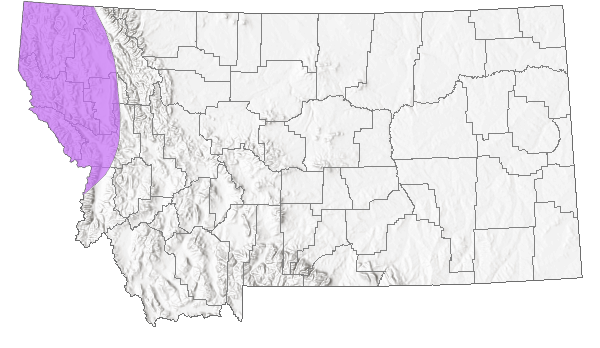
 Native
Native
Range Comments
Northern Idaho and northwestern Montana (Burke 2013). In Montana, reported west of the Continental Divide from Petty Creek, Missoula County: elevation 1036 m (3400 ft). Five shells of this species from the Petty Creek Montana locality deposited at the Field Museum of Natural History (FMNH 158844) by A. Solem (Hendricks 2012). The vouchers at the Field Museum need verification, and lack collector, date of collection, and specific coordinates. The catalog of Royal Bruce Brunson (unpublished) lists 5 shells of this species collected at this locality on 15 May 1948, and were likely collected by Brunson, sent to Solem for identification, and are the basis for the Montana record.
Observations in Montana Natural Heritage Program Database
Number of Observations: 1
(Click on the following maps and charts to see full sized version)
Map Help and Descriptions
Relative Density
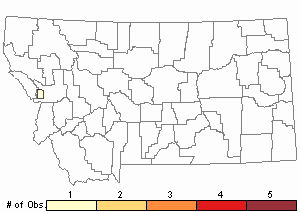
Recency

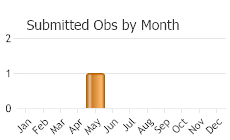
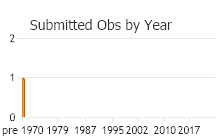
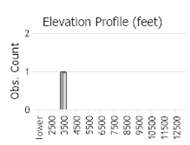 (Observations spanning multiple months or years are excluded from time charts)
(Observations spanning multiple months or years are excluded from time charts)
Habitat
Riparian wooded landscapes; ponderosa pine with a diversity of deciduous shrubs near springs and seeps. Found under woody debris, rocks, and in leaf litter (Hendricks 2012).
Stewardship Responsibility
References
- Literature Cited AboveLegend:
 View Online Publication
View Online Publication Burke, T. E. 2013. Land snails and slugs of the Pacific Northwest. Corvallis, OR: Oregon State University Press. 344 p.
Burke, T. E. 2013. Land snails and slugs of the Pacific Northwest. Corvallis, OR: Oregon State University Press. 344 p. Hendricks, P. 2012. A Guide to the Land Snails and Slugs of Montana. A report to the U.S. Forest Service - Region 1. Montana Natural Heritage Program, Helena, MT. vii + 187 pp. plus appendices.
Hendricks, P. 2012. A Guide to the Land Snails and Slugs of Montana. A report to the U.S. Forest Service - Region 1. Montana Natural Heritage Program, Helena, MT. vii + 187 pp. plus appendices.
- Additional ReferencesLegend:
 View Online Publication
View Online Publication
Do you know of a citation we're missing? Frest, T.J. and E.J. Johannes. 1995. Interior Columbia Basin mollusk species of special concern. Final report to the Interior Columbia Basin Ecosystem Management Project, Walla Walla, WA. Contract #43-0E00-4-9112. 274 pp. plus appendices.
Frest, T.J. and E.J. Johannes. 1995. Interior Columbia Basin mollusk species of special concern. Final report to the Interior Columbia Basin Ecosystem Management Project, Walla Walla, WA. Contract #43-0E00-4-9112. 274 pp. plus appendices. Frest, T.J. and E.J. Johannes. 2001. An annotated checklist of Idaho land and freshwater mollusks. Journal of the Idaho Academy of Science 36(2):1-51.
Frest, T.J. and E.J. Johannes. 2001. An annotated checklist of Idaho land and freshwater mollusks. Journal of the Idaho Academy of Science 36(2):1-51. Henderson, J. 1936. Mollusca of Colorado, Utah, Montana, Idaho, and Wyoming, supplement. University of Colorado Studies 23(2): 81-145.
Henderson, J. 1936. Mollusca of Colorado, Utah, Montana, Idaho, and Wyoming, supplement. University of Colorado Studies 23(2): 81-145. Pilsbry, H.A. 1940. Land Mollusca of North America (north of Mexico), Volume 1 Part 2. Monograph of the Academy of Natural Sciences of Philadelphia Monograph Number 3(1): 574-994.
Pilsbry, H.A. 1940. Land Mollusca of North America (north of Mexico), Volume 1 Part 2. Monograph of the Academy of Natural Sciences of Philadelphia Monograph Number 3(1): 574-994.
- Web Search Engines for Articles on "Kingston Oregonian"
- Additional Sources of Information Related to "Snails / Slugs"





